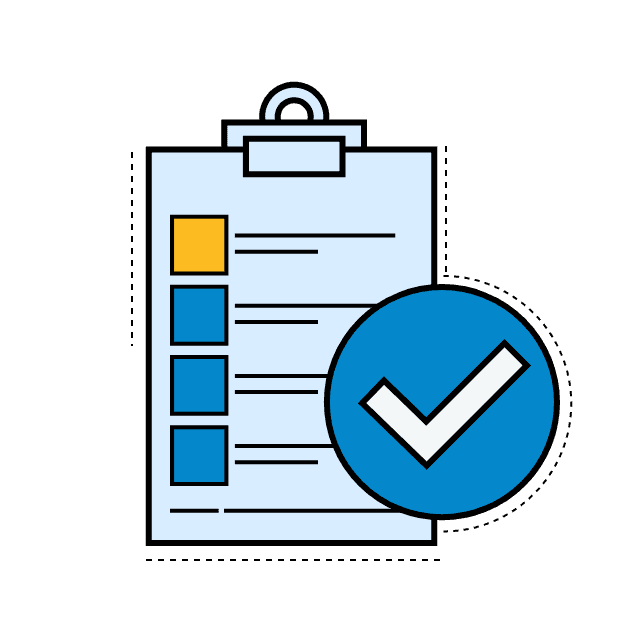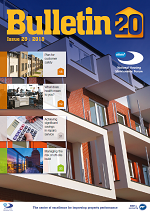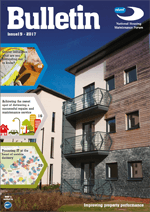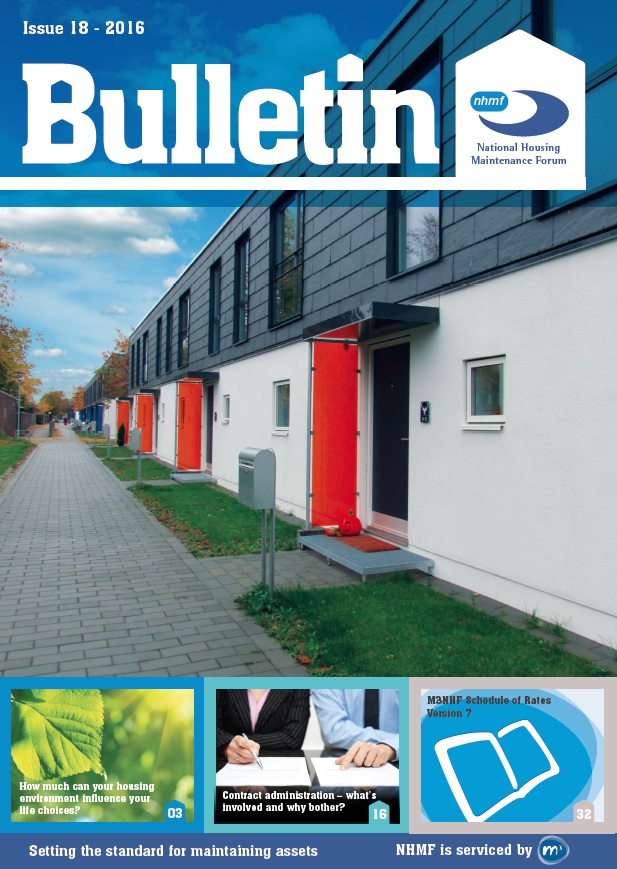NHMF best practice
These two new best practice sections will help social landlords to maintain quality homes in an increasingly challenging economic environment. The Compliance Section has a set of topical guides summarising social landlords’ responsibilities for meeting essential statutory health and safety requirements and explain how to do this economically and efficiently. The Fuel Saving Section explains how to include a fuel saving strategy as a key aspect of an organisation’s business plan. The Guide then sets out how to develop a practical improvement strategy as an integral part of the asset management programme and how to successfully deliver the improvements and manage the risks. There are also best practice training courses which relate to this guide.
Communal - External
Tree Management
Should include an up-to-date tree survey and risk assessment showing the location and condition of any hazardous trees (see NHMF 2015 Bulletin). Maintenance of trees, any work should be carried out to a minimum of BS 3998:2010 Tree work recommendations, with advice published by the Arboricultural Association.
Tree surgery and felling – works should comply with:
-
Relevant Forest Industry Safety Guides applicable at the time.
-
HSE has published guidance on ‘Working with chainsaws’ that includes training and competence in the use of chainsaws and the use of appropriate protective and safety equipment. HSENI has published guidance on farm safety that includes specific guidance on chainsaw safety.
-
Operatives should supply and erect all necessary warning and direction notices, cones, barriers and tapes to exclude members of the public from the working zone. The working zone should ensure that the tree and all equipment used remain within it.
-
Where work is carried out on the public highway, operatives should make the necessary arrangements with the Police and ensure that requirements of the ‘Traffic Signs Regulations and General Conditions 1981’ and subsequent amendments, are adhered to, along with the requirements of Chapter 8 of the ‘Traffic Signs Manual’ and subsequent amendments.
-
Grass Cutting – general H&S
-
Litter and leaf picking of grassed and planted areas – Litter collection and disposal should comply with the Food and Environmental Protection Act (FEPA), which HSE enforces (England, Wales and Scotland). All areas should be maintained up to the Grade A - No litter or refuse standard. Dog faeces should be cleared, as detailed under the FEPA and the Litter (Animal Droppings) Order (1991). Operatives should comply with The Control of Pollution Act (1974). Where needles (or other ‘sharps’ classified as European Waste Code 18 01 03) are found, these should be collected separately with the appropriate protective equipment and disposed of in special ‘sharps’ boxes. They should not be put in with any other waste. A waste carrier registered with the Environment Agency should be used to collect and dispose of ‘sharps’ boxes.
-
Maintenance of planted areas – general H&S duty of care
-
Hedge cutting – general H&S and also working at height requirements and regulations. (See also HSE brief guide that explains how to assess risks)
-
Horticultural works – Work should comply with BS 4428:1989 Code of practice for general landscape operations (excluding hard surfaces). The use of chemicals for the eradication of weeds should be in accordance with:
-
Health and Safety at Work Act 1974 (HSWA)
-
The Control of Pollution Act 1974, Netregs guidance is available for specific aspects, as well as guidance (for England, Wales and Scotland) published by DEFRA
-
The Control of Pesticides Regulations 1986, guidance on FEPA & COPR published by HSE
-
-
Maintenance of Void and OAP gardens – general H&S duty of care
HSE Statement 2012: Children’s Play and Leisure – Promoting a Balanced Approach. See also RoSPA for guidance.
Litter collection and disposal comply with the Food and Environmental Protection Act (FEPA). All areas should be maintained up to the Grade A - No litter or refuse standard. Dog faeces should be cleared, as detailed under the FEPA and the Litter (Animal Droppings) Order (1991). Operatives should comply with the Control of Pollution Act (1974). Where pesticides are used they should comply with the following guidelines and legislation, as amended or superseded from time to time:
-
The Food and Environmental Protection Act (1985) (FEPA).
-
The Control of Pesticides Regulations 1986 (COPR).
-
The Health and Safety at Work etc., Act (1974).
-
The Water Act (1989).
-
The Control of Pollution Act (1974).
-
The Control of Substances Hazardous to Health Regulations (1988) (COSHH).
Landlords need to manage external refuse and recycling areas as part of their general duty of care, including dealing with unauthorised dumping of waste and ensuring any hazardous waste is properly disposed of (see Asbestos). They also have to reduce fire risks from refuse to maintain fire safety (see Fire safety).
All cleaning materials should be COSHH approved and supported by written certification. In addition, landlords need to ensure that operatives comply with The Work at Height Regulations 2005 for both external cleaning of windows and for those in common parts. HSE has published guidance to explain organisations’ responsibilities and to help them comply with these regulations.
HSE has published guidance on barriers & powered gates & roller shutters. See Lift maintenance and access equipment.
In addition to ensuring electrical safety (see Electrical safety), landlords need to ensure that communal aerials and satellite systems are securely fixed to buildings. Any external equipment needs to be suitably housed in weatherproof enclosures and fire safety should be maintained where cables are routed within buildings. Operatives installing and maintaining communal TV aerials should comply with The Work at Height Regulations 2005.
Equipment should comply with the following standards and codes of practice, as well as industry good practice:-
-
BS EN 60728-4:2008 Cable networks for television signals, sound signals and interactive services. Passive wideband equipment for coaxial cable networks;
-
BS EN 50117-2-1:2005+A2:2013 Coaxial cables. Sectional specification for cables used in cabled distribution networks. Indoor drop cables for systems operating at 5 MHz-1000 MHz;
-
BS EN 60966-3:2009 Radio frequency and coaxial cable assemblies. Sectional specification for semi-flexible coaxial cable assemblies;
-
BS 4662:2006+A1:2009 Boxes for flush mounting of electrical accessories. Requirements, test methods and dimensions;
-
BS 7671:2008+A3:2015 Requirements for Electrical Installations.
The workmanship, installation, and testing of the lightning protection system should conform in all respects with BS EN 62305:2011. BSI has also published a guide. See Electrical safety.




